YAMAHA SR400 2016 Workshop Manual
Manufacturer: YAMAHA, Model Year: 2016, Model line: SR400, Model: YAMAHA SR400 2016Pages: 96, PDF Size: 2.52 MB
Page 51 of 96
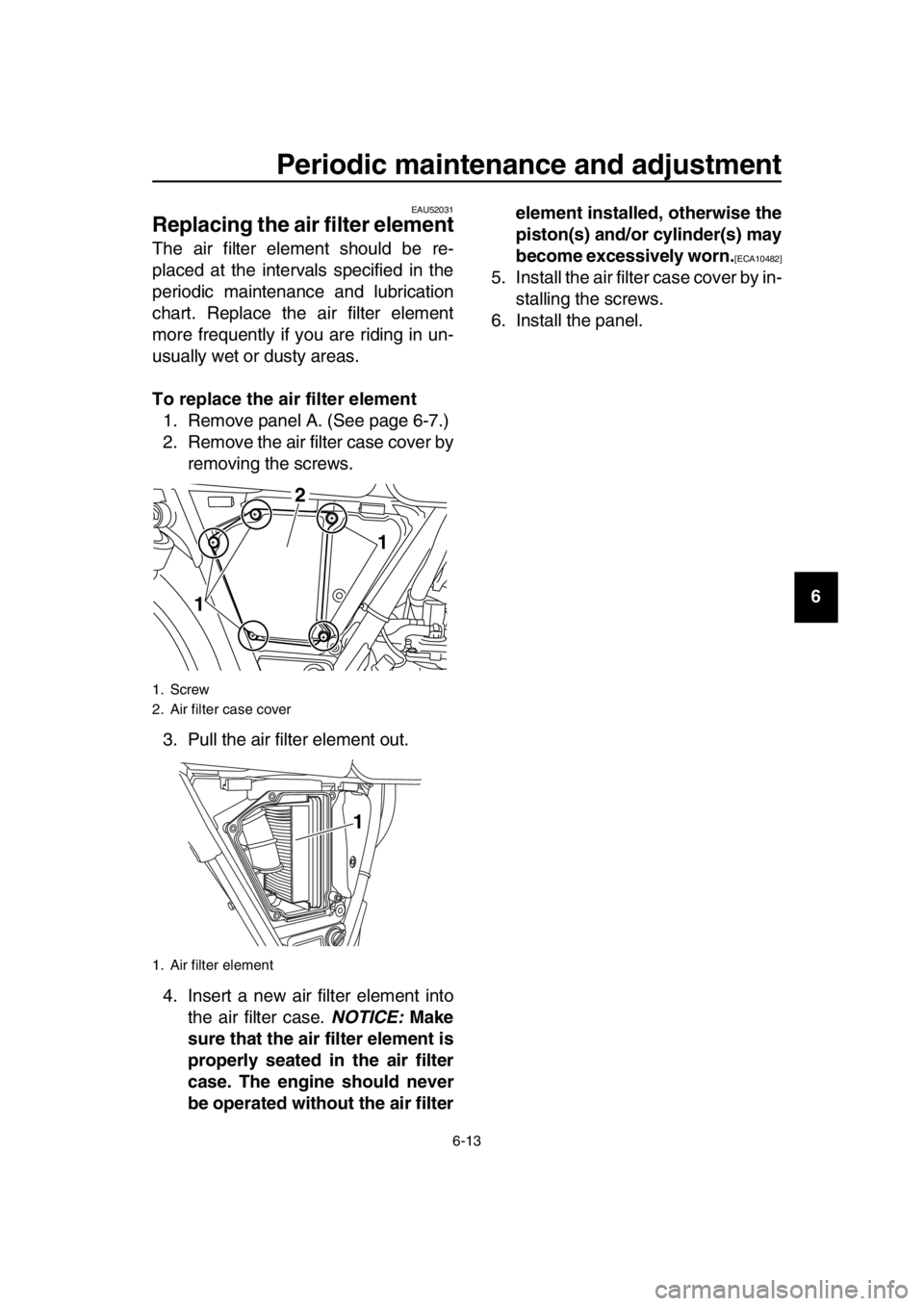
Periodic maintenance and adjustment
6-13
1
2
3
4
5
6
7
8
9
10
11
12
13
14
EAU52031
Replacing the air filter element
The air filter element should be re-
placed at the intervals specified in the
periodic maintenance and lubrication
chart. Replace the air filter element
more frequently if you are riding in un-
usually wet or dusty areas.
To replace the air filter element 1. Remove panel A. (See page 6-7.)
2. Remove the air filter case cover by removing the screws.
3. Pull the air filter element out.
4. Insert a new air filter element into the air filter case. NOTICE: Make
sure that the air filter element is
properly seated in the air filter
case. The engine should never
be operated without the air filter element installed, otherwise the
piston(s) and/or cylinder(s) may
become excessively worn.[ECA10482]
5. Install the air filter case cover by in-
stalling the screws.
6. Install the panel.
1. Screw
2. Air filter case cover
1. Air filter element
1
2
1
1
2RD-28199-E1.book 13 ページ 2015年9月3日 木曜日 午後3時42分
Page 52 of 96
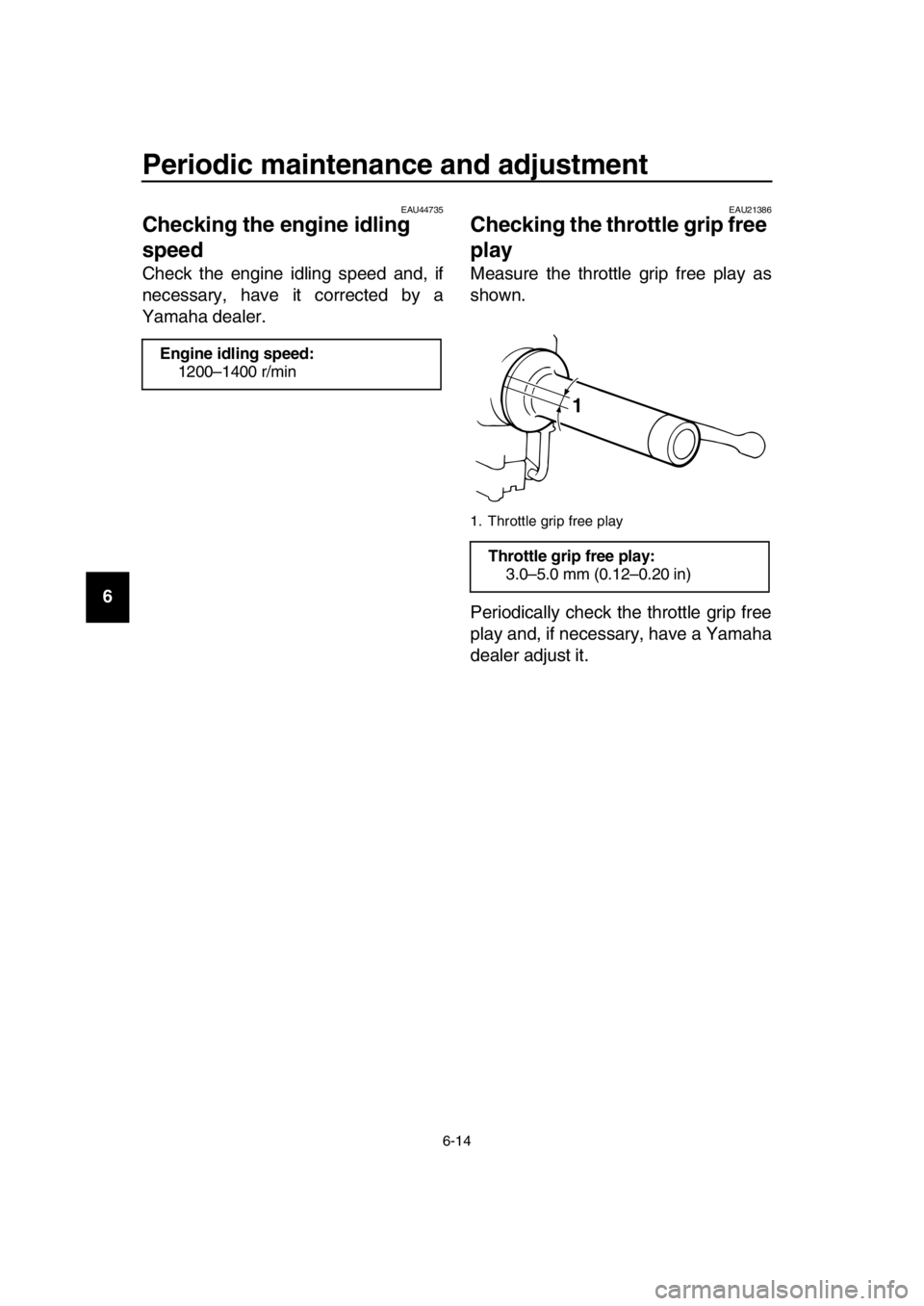
Periodic maintenance and adjustment
6-14
1
2
3
4
5
6
7
8
9
10
11
12
13
14
EAU44735
Checking the engine idling
speed
Check the engine idling speed and, if
necessary, have it corrected by a
Yamaha dealer.
EAU21386
Checking the throttle grip free
play
Measure the throttle grip free play as
shown.
Periodically check the throttle grip free
play and, if necessary, have a Yamaha
dealer adjust it.
Engine idling speed: 1200–1400 r/min
1. Throttle grip free play
Throttle grip free play:3.0–5.0 mm (0.12–0.20 in)
1
2RD-28199-E1.book 14 ページ 2015年9月3日 木曜日 午後3時42分
Page 53 of 96
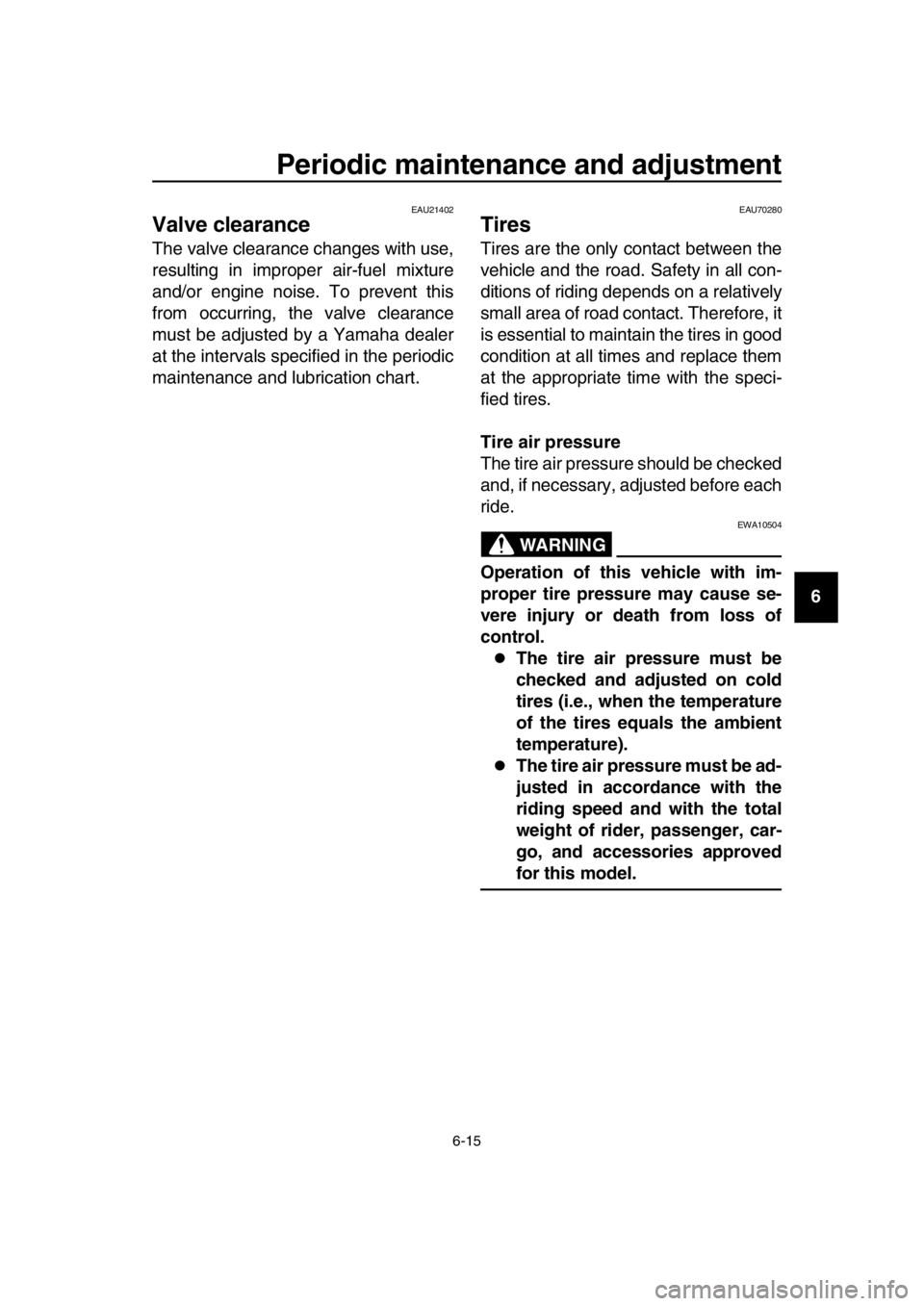
Periodic maintenance and adjustment
6-15
1
2
3
4
5
6
7
8
9
10
11
12
13
14
EAU21402
Valve clearance
The valve clearance changes with use,
resulting in improper air-fuel mixture
and/or engine noise. To prevent this
from occurring, the valve clearance
must be adjusted by a Yamaha dealer
at the intervals specified in the periodic
maintenance and lubrication chart.
EAU70280
Tires
Tires are the only contact between the
vehicle and the road. Safety in all con-
ditions of riding depends on a relatively
small area of road contact. Therefore, it
is essential to maintain the tires in good
condition at all times and replace them
at the appropriate time with the speci-
fied tires.
Tire air pressure
The tire air pressure should be checked
and, if necessary, adjusted before each
ride.
WARNING
EWA10504
Operation of this vehicle with im-
proper tire pressure may cause se-
vere injury or death from loss of
control.
The tire air pressure must be
checked and adjusted on cold
tires (i.e., when the temperature
of the tires equals the ambient
temperature).
The tire air pressure must be ad-
justed in accordance with the
riding speed and with the total
weight of rider, passenger, car-
go, and accessories approved
for this model.
2RD-28199-E1.book 15 ページ 2015年9月3日 木曜日 午後3時42分
Page 54 of 96
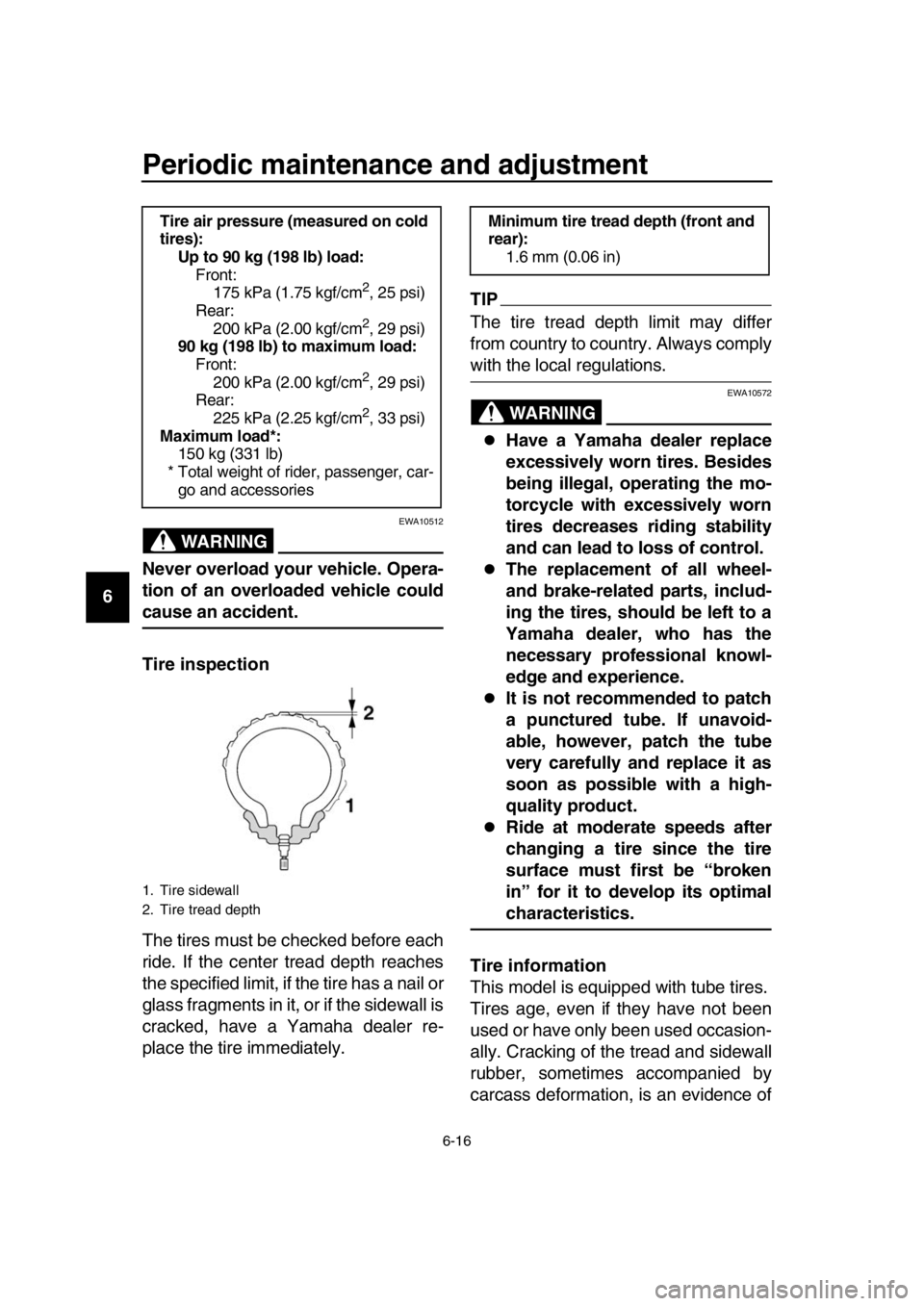
Periodic maintenance and adjustment
6-16
1
2
3
4
5
6
7
8
9
10
11
12
13
14
WARNING
EWA10512
Never overload your vehicle. Opera-
tion of an overloaded vehicle could
cause an accident.
Tire inspection
The tires must be checked before each
ride. If the center tread depth reaches
the specified limit, if the tire has a nail or
glass fragments in it, or if the sidewall is
cracked, have a Yamaha dealer re-
place the tire immediately.
TIP
The tire tread depth limit may differ
from country to country. Always comply
with the local regulations.
WARNING
EWA10572
Have a Yamaha dealer replace
excessively worn tires. Besides
being illegal, operating the mo-
torcycle with excessively worn
tires decreases riding stability
and can lead to loss of control.
The replacement of all wheel-
and brake-related parts, includ-
ing the tires, should be left to a
Yamaha dealer, who has the
necessary professional knowl-
edge and experience.
It is not recommended to patch
a punctured tube. If unavoid-
able, however, patch the tube
very carefully and replace it as
soon as possible with a high-
quality product.
Ride at moderate speeds after
changing a tire since the tire
surface must first be “broken
in” for it to develop its optimal
characteristics.
Tire information
This model is equipped with tube tires.
Tires age, even if they have not been
used or have only been used occasion-
ally. Cracking of the tread and sidewall
rubber, sometimes accompanied by
carcass deformation, is an evidence of
Tire air pressure (measured on cold
tires): Up to 90 kg (198 lb) load:Front:175 kPa (1.75 kgf/cm
2, 25 psi)
Rear: 200 kPa (2.00 kgf/cm
2, 29 psi)
90 kg (198 lb) to maximum load:
Front:200 kPa (2.00 kgf/cm
2, 29 psi)
Rear:
225 kPa (2.25 kgf/cm
2, 33 psi)
Maximum load*: 150 kg (331 lb)
* Total weight of rider, passenger, car- go and accessories
1. Tire sidewall
2. Tire tread depth
Minimum tire tread depth (front and
rear): 1.6 mm (0.06 in)
2RD-28199-E1.book 16 ページ 2015年9月3日 木曜日 午後3時42分
Page 55 of 96

Periodic maintenance and adjustment
6-17
1
2
3
4
5
6
7
8
9
10
11
12
13
14
ageing. Old and aged tires shall be
checked by tire specialists to ascertain
their suitability for further use.
WARNING
EWA10462
The front and rear tires should be of
the same make and design, other-
wise the handling characteristics of
the vehicle may be different, which
could lead to an accident.
After extensive tests,
only the tires list-
ed below have been approved for this
model by Yamaha.
EAU21944
Spoke wheels
WARNING
EWA10611
The wheels on this model are not de-
signed for use with tubeless tires.
Do not attempt to use tubeless tires
on this model.
To maximize the performance, durabil-
ity, and safe operation of your motorcy-
cle, note the following points regarding
the specified wheels.
The wheel rims should be checked
for cracks, bends, warpage or oth-
er damage, and the spokes for
looseness or damage before each
ride. If any damage is found, have
a Yamaha dealer replace the
wheel. Do not attempt even the
smallest repair to the wheel. A de-
formed or cracked wheel must be
replaced.
The wheel should be balanced
whenever either the tire or wheel
has been changed or replaced. An
unbalanced wheel can result in
poor performance, adverse han-
dling characteristics, and a short-
ened tire life.
Front tire: Size:90/100-18M/C 54S
Manufacturer/model:
BRIDGESTONE/BT-45F
Rear tire: Size:
110/90-18M/C 61S
Manufacturer/model: BRIDGESTONE/BT-45R
2RD-28199-E1.book 17 ページ 2015年9月3日 木曜日 午後3時42分
Page 56 of 96
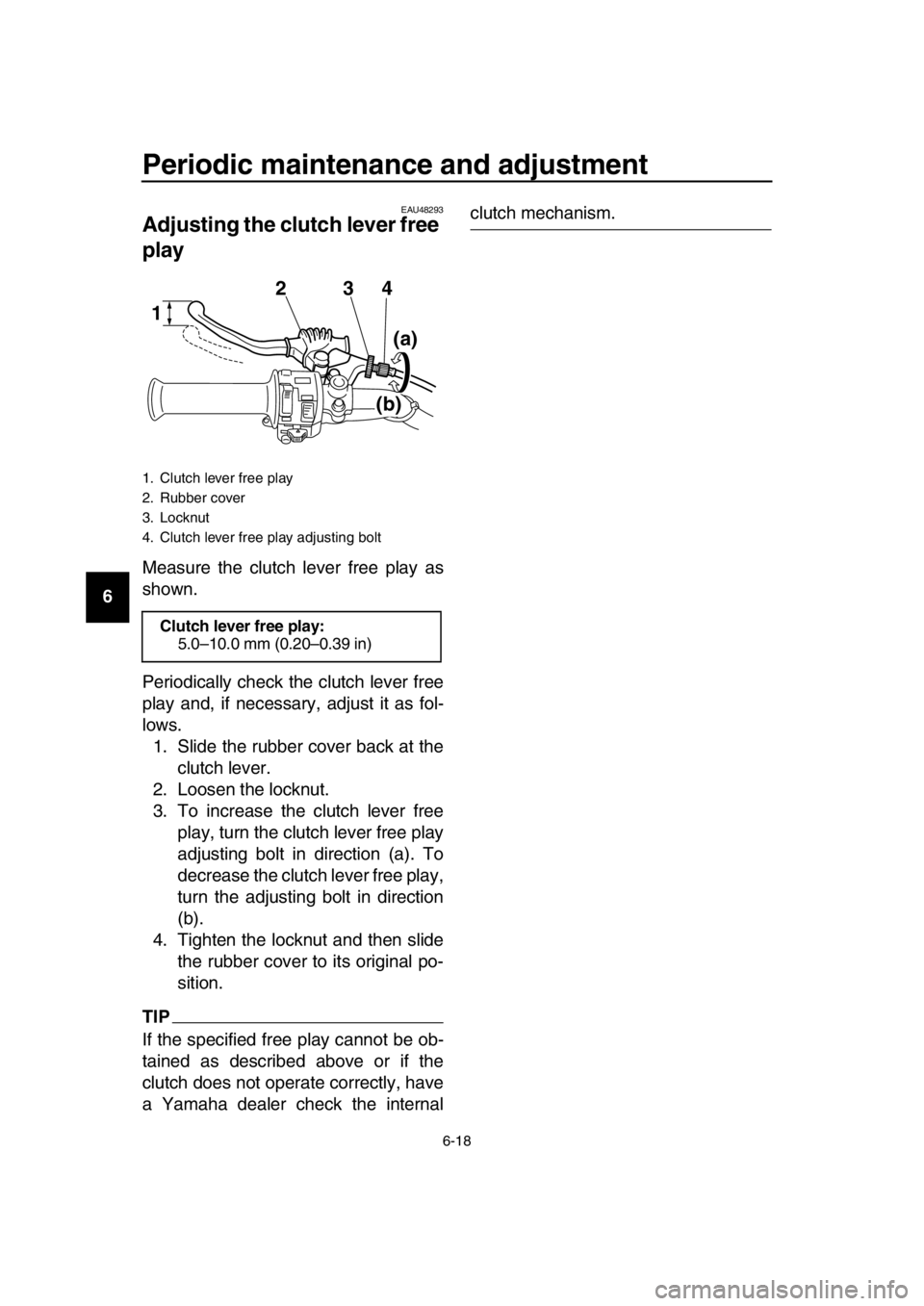
Periodic maintenance and adjustment
6-18
1
2
3
4
5
6
7
8
9
10
11
12
13
14
EAU48293
Adjusting the clutch lever free
play
Measure the clutch lever free play as
shown.
Periodically check the clutch lever free
play and, if necessary, adjust it as fol-
lows. 1. Slide the rubber cover back at the clutch lever.
2. Loosen the locknut.
3. To increase the clutch lever free play, turn the clutch lever free play
adjusting bolt in direction (a). To
decrease the clutch lever free play,
turn the adjusting bolt in direction
(b).
4. Tighten the locknut and then slide the rubber cover to its original po-
sition.
TIP
If the specified free play cannot be ob-
tained as described above or if the
clutch does not operate correctly, have
a Yamaha dealer check the internal
clutch mechanism.
1. Clutch lever free play
2. Rubber cover
3. Locknut
4. Clutch lever free play adjusting bolt
Clutch lever free play:5.0–10.0 mm (0.20–0.39 in)
324
(a)
(b)
1
2RD-28199-E1.book 18 ページ 2015年9月3日 木曜日 午後3時42分
Page 57 of 96
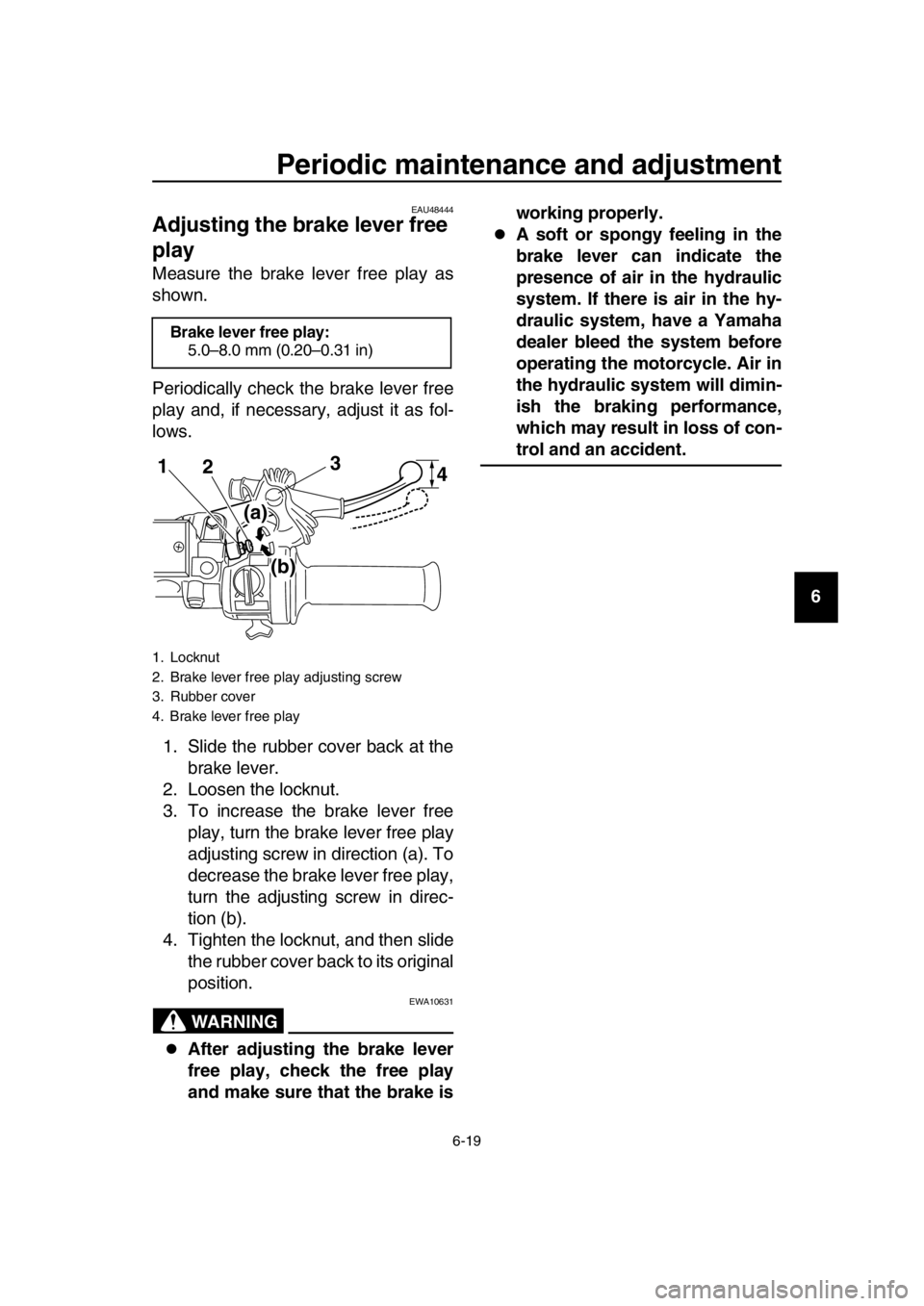
Periodic maintenance and adjustment
6-19
1
2
3
4
5
6
7
8
9
10
11
12
13
14
EAU48444
Adjusting the brake lever free
play
Measure the brake lever free play as
shown.
Periodically check the brake lever free
play and, if necessary, adjust it as fol-
lows.
1. Slide the rubber cover back at the brake lever.
2. Loosen the locknut.
3. To increase the brake lever free play, turn the brake lever free play
adjusting screw in direction (a). To
decrease the brake lever free play,
turn the adjusting screw in direc-
tion (b).
4. Tighten the locknut, and then slide the rubber cover back to its original
position.
WARNING
EWA10631
After adjusting the brake lever
free play, check the free play
and make sure that the brake is working properly.
A soft or spongy feeling in the
brake lever can indicate the
presence of air in the hydraulic
system. If there is air in the hy-
draulic system, have a Yamaha
dealer bleed the system before
operating the motorcycle. Air in
the hydraulic system will dimin-
ish the braking performance,
which may result in loss of con-
trol and an accident.
Brake lever free play:
5.0–8.0 mm (0.20–0.31 in)
1. Locknut
2. Brake lever free play adjusting screw
3. Rubber cover
4. Brake lever free play
2 3
1
(a)
(b)
4
2RD-28199-E1.book 19 ページ 2015年9月3日 木曜日 午後3時42分
Page 58 of 96
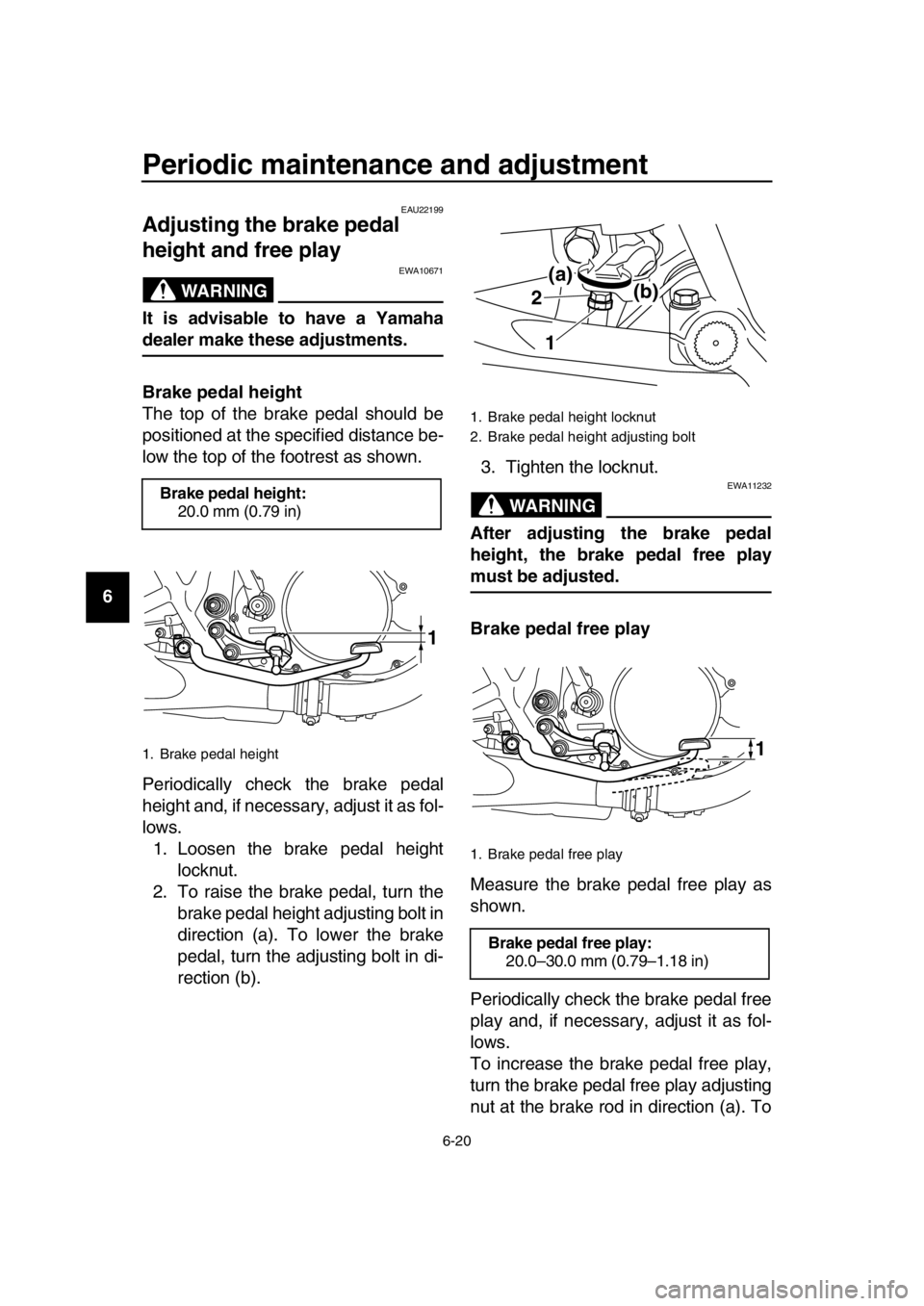
Periodic maintenance and adjustment
6-20
1
2
3
4
5
6
7
8
9
10
11
12
13
14
EAU22199
Adjusting the brake pedal
height and free play
WARNING
EWA10671
It is advisable to have a Yamaha
dealer make these adjustments.
Brake pedal height
The top of the brake pedal should be
positioned at the specified distance be-
low the top of the footrest as shown.
Periodically check the brake pedal
height and, if necessary, adjust it as fol-
lows. 1. Loosen the brake pedal height locknut.
2. To raise the brake pedal, turn the brake pedal height adjusting bolt in
direction (a). To lower the brake
pedal, turn the adjusting bolt in di-
rection (b). 3. Tighten the locknut.
WARNING
EWA11232
After adjusting the brake pedal
height, the brake pedal free play
must be adjusted.
Brake pedal free play
Measure the brake pedal free play as
shown.
Periodically check the brake pedal free
play and, if necessary, adjust it as fol-
lows.
To increase the brake pedal free play,
turn the brake pedal free play adjusting
nut at the brake rod in direction (a). To
Brake pedal height:
20.0 mm (0.79 in)
1. Brake pedal height
1
1. Brake pedal height locknut
2. Brake pedal height adjusting bolt
1. Brake pedal free play
Brake pedal free play:20.0–30.0 mm (0.79–1.18 in)
1
2
(b)
(a)
1
2RD-28199-E1.book 20 ページ 2015年9月3日 木曜日 午後3時42分
Page 59 of 96
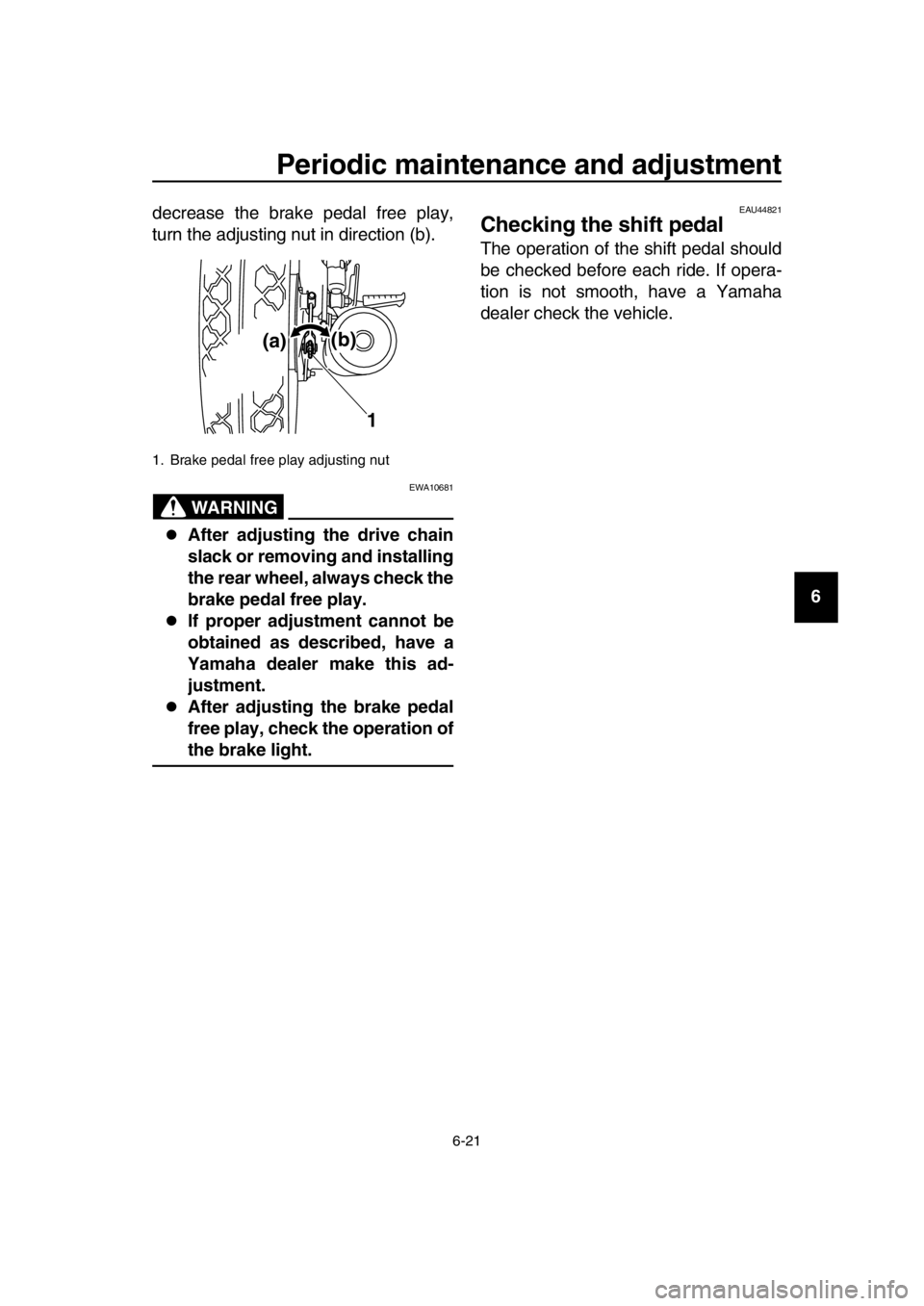
Periodic maintenance and adjustment
6-21
1
2
3
4
5
6
7
8
9
10
11
12
13
14
decrease the brake pedal free play,
turn the adjusting nut in direction (b).
WARNING
EWA10681
After adjusting the drive chain
slack or removing and installing
the rear wheel, always check the
brake pedal free play.
If proper adjustment cannot be
obtained as described, have a
Yamaha dealer make this ad-
justment.
After adjusting the brake pedal
free play, check the operation of
the brake light.
EAU44821
Checking the shift pedal
The operation of the shift pedal should
be checked before each ride. If opera-
tion is not smooth, have a Yamaha
dealer check the vehicle.
1. Brake pedal free play adjusting nut
(b)
(a)
1
2RD-28199-E1.book 21 ページ 2015年9月3日 木曜日 午後3時42分
Page 60 of 96
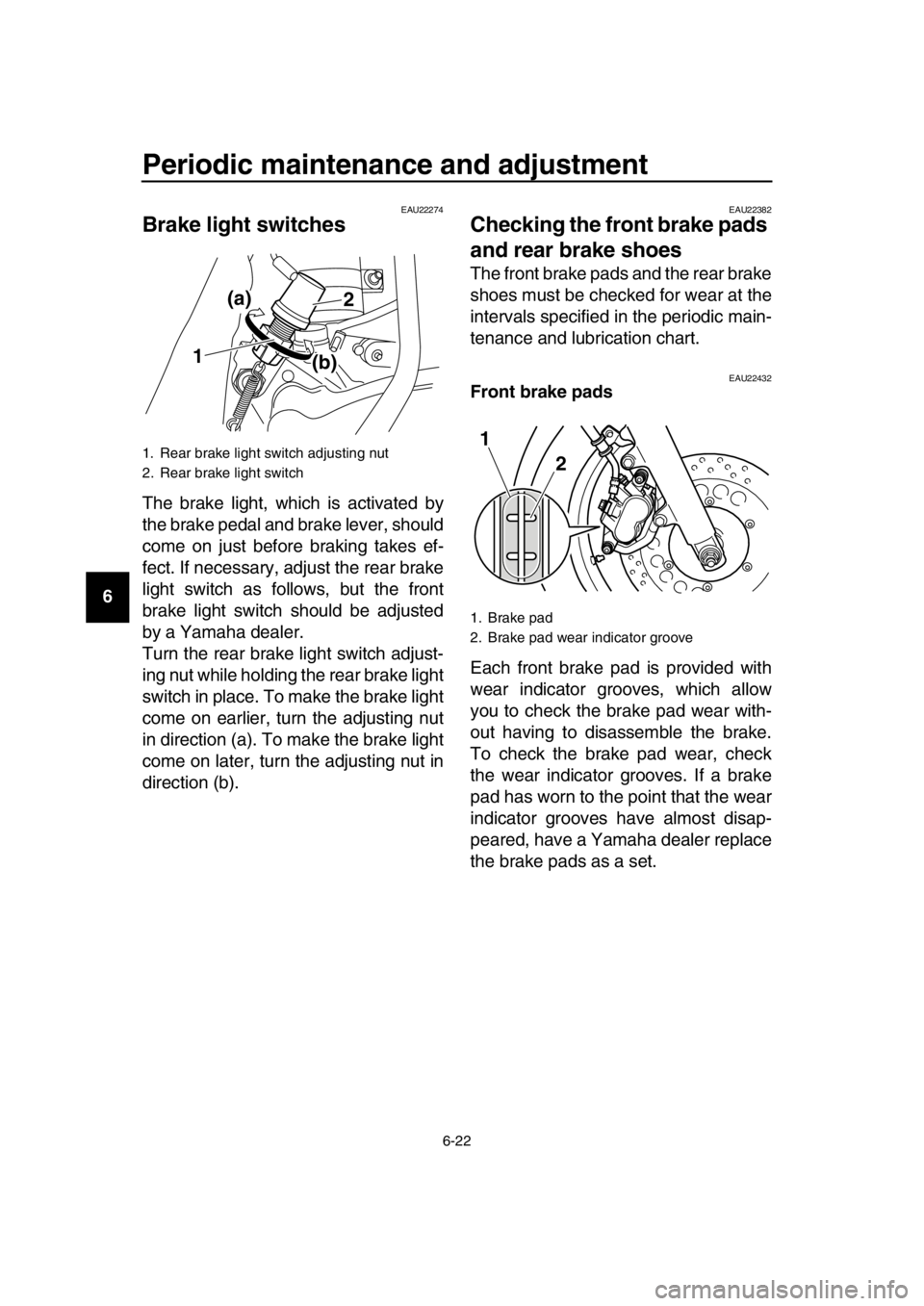
Periodic maintenance and adjustment
6-22
1
2
3
4
5
6
7
8
9
10
11
12
13
14
EAU22274
Brake light switches
The brake light, which is activated by
the brake pedal and brake lever, should
come on just before braking takes ef-
fect. If necessary, adjust the rear brake
light switch as follows, but the front
brake light switch should be adjusted
by a Yamaha dealer.
Turn the rear brake light switch adjust-
ing nut while holding the rear brake light
switch in place. To make the brake light
come on earlier, turn the adjusting nut
in direction (a). To make the brake light
come on later, turn the adjusting nut in
direction (b).
EAU22382
Checking the front brake pads
and rear brake shoes
The front brake pads and the rear brake
shoes must be checked for wear at the
intervals specified in the periodic main-
tenance and lubrication chart.
EAU22432Front brake pads
Each front brake pad is provided with
wear indicator grooves, which allow
you to check the brake pad wear with-
out having to disassemble the brake.
To check the brake pad wear, check
the wear indicator grooves. If a brake
pad has worn to the point that the wear
indicator grooves have almost disap-
peared, have a Yamaha dealer replace
the brake pads as a set.
1. Rear brake light switch adjusting nut
2. Rear brake light switch
2
1 (a)
(b)
1. Brake pad
2. Brake pad wear indicator groove
12
2RD-28199-E1.book 22 ページ 2015年9月3日 木曜日 午後3時42分